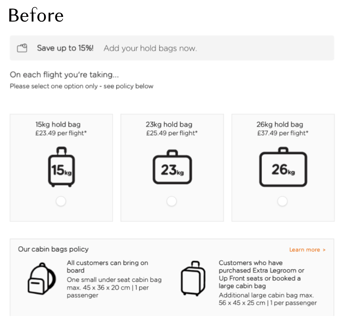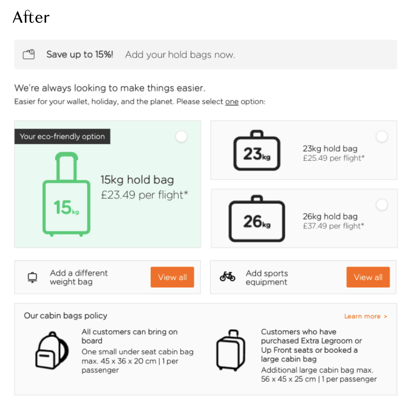easyJet has committed to achieving net-zero emissions by 2050. Their efforts include investments in Sustainable Aviation Fuel, innovative technologies for zero-carbon flights, carbon removal initiatives, offsets, and operational enhancements. However, transformative changes at the foundational, systemic, and operational levels are only part of the solution. The other, potentially more challenging aspect, rests in the hands of the consumer.
For genuine progress toward sustainable air travel, airlines must also encourage and facilitate their customers to proactively choose eco-friendly travel options. easyJet is now actively exploring how Behavioural Science can be serving knowledge and choices that enable customers to contribute to the shared goal of achieving net-zero emissions.

Transform customer experiences
To kickstart this journey to shifting their customer preferences towards more sustainable travel, easyJet set out with the goal of reducing each customer’s individual carbon footprint by nudging them to choose a lighter bag option.

Customers who aren’t inherently motivated by the motion towards sustainability face several psychological barriers which stand in the way of them choosing lighter baggage.
Most don’t even know that heavier aircrafts have greater carbon emissions.
Some do, but don’t feel as though packing lighter themselves will make any significant difference to solving the greater problem at hand.
Under the surface and in the subconscious, customers are also grappling with an empathy gap - finding it hard to imagine what the needs and wants of their future selves will be when it comes to the day they need to actually start packing…
So, they opt for what is safe. Larger bags offer customers more certainty around how much they can pack, reducing the anticipation of loss we fear for having to remove items when we’ve not got enough space to pack them.
In reality, though, on the big day itself… we pack what we do because we’ve got the space to. We’re anchored to the weight and size of the bag we’ve already purchased, and we pack more to maximise the space we’ve got, making use of the money already spent to confirm that we were right all along - we needed that bag.
…but how much are our choices actually determined by how the options are presented?
To kickstart this journey to shifting their customer preferences towards more sustainable travel, easyJet set out with the goal of reducing each customer’s individual carbon footprint by nudging them to choose a lighter bag option.
By using colour and size to create contrast on the page, we can enhance the visual saliency of the lighter bag option so that it would attract more attention relative to the others on offer, while shifting the customer’s focus to consider the eco-friendly impact behind the lighter choice.
Take a look at this before and after to see exactly what we did to achieve this:

 Saliency
Saliency
The saliency of the 15kg bag option is driven by its size and colour. Salient options attract customer attention and make them more likely to be considered and chosen. Framing
Framing
We judge the importance of an object by its relative size to others around it. Since the 15kg option is twice as large, customers are more likely to perceive it as twice as popular, making it more likely to be chosen.

The change was simple, yes. But its impact was significant...
Customers across the UK, France, Italy and Spain proceeding through the newly designed and behaviourally-optimised checkout flow were 62% more likely to choose the 15kg option over the 23kg option, and 35% more likely to to choose it over the 26kg option.
Yes, easyJet’s emissions goals are ambitious. And yes, there are many challenges for us to still consider.
How, for example, can we make sure customers are packing within 15kg so that they don’t just buy additional baggage on the day itself? How can we help customers consider packing just a backpack for shorter trips? What other ways can the customer contribute to reducing carbon emissions more broadly? And, how can we nudge them towards those?
There’s no doubt that there is plenty of work to do in accelerating progress and looking for breakthroughs to shape the next generation of sustainable air travel. But with the choices a customer makes for each flight at the heart of what fuels easyJet as a brand and business, it’s those small tweaks in the choice architecture which lead to seemingly minimal changes to behaviour that - through their cumulative effects and normative shifts - are required to transform a culture of sustainable travel.
30 January
Read about how Cowry helped Tesco Bank to reduce overall operational costs and environmental impact by encouraging customers to go paperless.
13 March
Read about how Cowry helped Southern Water's contact centre teams in driving compelling conversations and positive customer interactions.
We’d love to chat to you about how to start applying behavioural science - book a slot below to catch up with Jez and find out more.
Download your free copy of On The Brain 📖